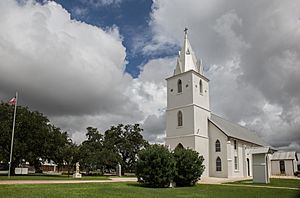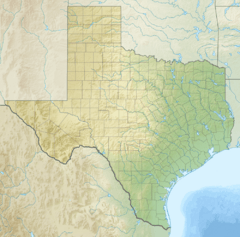Panna Maria, Texas facts for kids
Quick facts for kids
Panna Maria, Texas
|
|
|---|---|

Immaculate Conception Catholic Church
|
|
| Country | United States |
| State | Texas |
| County | Karnes |
| Time zone | UTC-6 (Central (CST)) |
| • Summer (DST) | UTC-5 (CDT) |
| ZIP codes |
78144
|
| GNIS feature ID | 1364749 |
|
Panna Maria Historic District
|
|
| Area | 2,400 acres (970 ha) |
| Built | 1854 |
| Architectural style | Gothic Revival, Polish Colonial |
| NRHP reference No. | 76002043 |
| Added to NRHP | May 13, 1976 |
Panna Maria is a small community in Karnes County, Texas, United States. Its name means "Virgin Mary" in Polish. This town is very special because it is the oldest Polish settlement in the United States.
Contents
History of Panna Maria
How the Town Started
In 1852, a Franciscan missionary named Father Leopold Moczygemba began inviting people from Upper Silesia to move to America. At that time, Silesia was part of the Kingdom of Prussia. These brave immigrants arrived in Indianola, Texas, in early December 1854.
It was hard to find carts to carry their belongings inland. So, the immigrants walked all the way to their new land near San Antonio. They officially settled the town on Christmas Eve in 1854.
Keeping Polish Culture Alive
Panna Maria became a strong Polish community for several reasons:
- The railroads did not build tracks through the town. This meant Panna Maria stayed a bit isolated from other places.
- The settlers supported the Union during the American Civil War. This was different from many people in Texas at the time.
- Resurrectionist priests from Europe came to live and work in the town.
- A group of Polish teaching nuns also started a sisterhood there.
These factors helped the people of Panna Maria keep their Polish traditions. Even today, some people still speak the Texas Silesian dialect. This is a special way of speaking Polish that developed in Texas.
Panna Maria's Historic Status
The Panna Maria Historic District is a very important place. It is listed on the National Register of Historic Places. This means it is recognized for its historical value and is protected.




